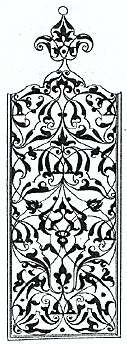Moresque ornament, Peter Flötner.jpg on:
[Wikipedia]
[Google]
[Amazon]

 Moresque is an obsolete alternative term to "
Moresque is an obsolete alternative term to "
Google books
/ref>

 Moresque is an obsolete alternative term to "
Moresque is an obsolete alternative term to "Moorish
The term Moor, derived from the ancient Mauri, is an exonym first used by Christian Europeans to designate the Muslim inhabitants of the Maghreb, the Iberian Peninsula, Sicily and Malta during the Middle Ages.
Moors are not a distinct or se ...
" in English, and in the arts has some specific meanings. By itself, the word is used to describe the stylized plant-based forms of tendrils and leaves found in ornament
An ornament is something used for decoration.
Ornament may also refer to:
Decoration
* Ornament (art), any purely decorative element in architecture and the decorative arts
* Biological ornament, a characteristic of animals that appear to serve ...
and decoration in the applied arts in Renaissance Europe that are derived from the arabesque patterns of Islamic ornament. Like their Islamic ancestors, they differ from the typical European plant scroll in being many-branched and spreading rather than forming a line in one direction. The use of half-leaves with their longest side running along the stem is typical for both.
First found in 15th-century Italy, especially Venice
Venice ( ; it, Venezia ; vec, Venesia or ) is a city in northeastern Italy and the capital of the Veneto Regions of Italy, region. It is built on a group of 118 small islands that are separated by canals and linked by over 400 ...
, moresques continue in the Mannerist and Northern Mannerist styles of the 16th century.
Figures
Another, related, meaning was defined in 1611 by Randle Cotgrave's ''A Dictionarie of the French and English Tongues'' as: "a rude or anticke painting, or carving, wherin the feet and tayles of beasts, &c, are intermingled with, or made to resemble, a kind of wild leaves, &c." The word was also used for such a figure, starting off as a human or animal, but terminating as part of a decorative scheme of foliage or geometric strapwork. In fact the origin of figures like those described by Cotgrave comes not from the Islamic world, but from the Renaissance version, influenced by the Ancient Roman grotesque decorative style, of medieval ornament, especially that found inilluminated manuscript
An illuminated manuscript is a formally prepared document where the text is often supplemented with flourishes such as borders and miniature illustrations. Often used in the Roman Catholic Church for prayers, liturgical services and psalms, the ...
s. Here men and beasts whose forms disappear into geometric or foliage decoration go back almost a thousand years to the interlace of Insular art
Insular art, also known as Hiberno-Saxon art, was produced in the post-Roman era of Great Britain and Ireland. The term derives from ''insula'', the Latin term for "island"; in this period Britain and Ireland shared a largely common style dif ...
seen in the Book of Kells
The Book of Kells ( la, Codex Cenannensis; ga, Leabhar Cheanannais; Dublin, Trinity College Library, MS A. I. 8 sometimes known as the Book of Columba) is an illuminated manuscript Gospel book in Latin, containing the four Gospels of the New ...
and other manuscripts. These themselves derive from the Animal style
Animal style art is an approach to decoration found from China to Northern Europe in the early Iron Age, and the barbarian art of the Migration Period, characterized by its emphasis on animal motifs. The zoomorphic style of decoration was used ...
of barbarian
A barbarian (or savage) is someone who is perceived to be either Civilization, uncivilized or primitive. The designation is usually applied as a generalization based on a popular stereotype; barbarians can be members of any nation judged by som ...
Europe. However, the term ''moresque'' is not used of these medieval versions.
Book covers
Tooled and decorated finebookbinding
Bookbinding is the process of physically assembling a book of codex format from an ordered stack of ''signatures'', sheets of paper folded together into sections that are bound, along one edge, with a thick needle and strong thread. Cheaper, b ...
s and printer's ornaments marking the end of a chapter were one of the first places where the style appeared, in 15th century Italy. Moresque decoration remained a common element in decorated book bindings throughout the 16th century, and across Europe, often combined with strapwork or bandwork.
Other meanings
*"Moresque dance" is a fancy term for the English Morris dance (OED, quoting Chambers' Cyclopaedia, or Universal Dictionary of Arts and Sciences, 1727). See also the RenaissanceMoresca
Moresca (Italian), morisca (Spanish), mourisca (Portuguese) or moresque, mauresque (French), also known in French as the danse des bouffons, is a dance of exotic character encountered in Europe in the Renaissance period. This dance usually took fo ...
dances of France and Italy, called "moresques" in French.
*Hispano-Moresque ware
Hispano-Moresque ware is a style of initially Islamic pottery created in Al-Andalus, which continued to be produced under Christian rule in styles blending Islamic and European elements. It was the most elaborate and luxurious pottery being pr ...
is a type of medieval and Renaissance fine pottery produced in Spain by both Muslims and Christians.
*The term "Hispano-Moresque" is also used to describe figured silk textiles with geometric patterns woven in medieval Andalusia.
* In 18th century French, moresques were "large loose comfortable pantaloons of thin printed calico"./ref>
See also
* MoriscoReferences
Further reading
* {{Ornaments Visual motifs Mannerism Decorative arts Ornaments